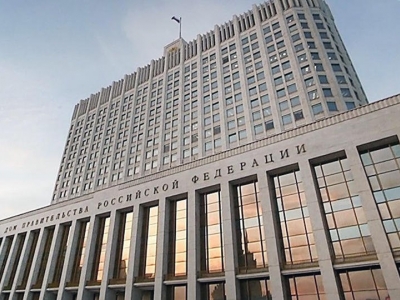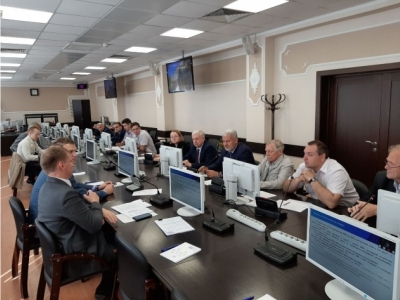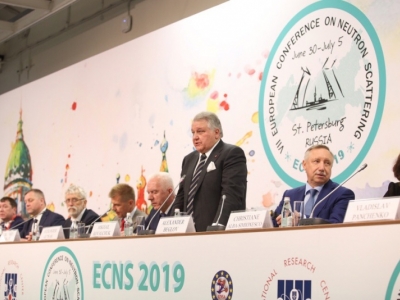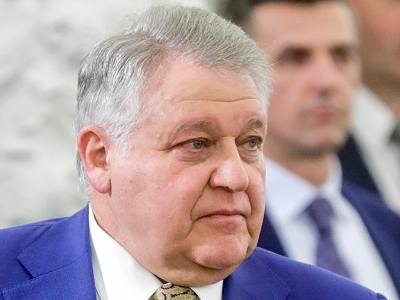An Agreement on Cooperation with the European XFEL X-ray Free Electron Laser Center (Germany) is signed in IKBFU
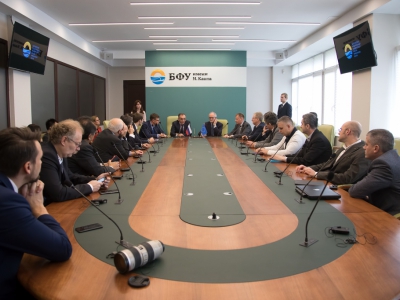
Andrey Klemeshev, Rector of IKBFU and the managing director of the European Center for X-ray Free Electron Laser XFEL (Hamburg, Germany) Robert Feidenhans’l signed an agreement on cooperation.
СThe parties noted the urgency of the event, because X-ray free-electron lasers, modern megascience research facilities, are capable of creating super-intensive X-ray beams. Being the brightest X-ray source in the world, XFEL is ready to accept the challenges that exist today in both fundamental science and technological applications.
The participants of the meeting were greeted by Andrey Klemeshev, Rector of IKBFU.
"I am very glad that our colleagues are here today. We have long established good positive relationship. And I hope that the signing of the agreement will give a new impetus for the collaboration between scientists."
Robert Feidenhans’l, the managing director of the European Center for X-ray Free Electron Laser XFEL:
"I am very pleased to be present today in the IKBFU. We are pleased that a new partnership page is opening. We have a great mutual scientific interest. Now our teams will be able to exchange technologies in the field of optics, develop new technologies in the field of laser optics, which are necessary for our everyday work. Many thanks for such a desire to cooperate!"
During the ceremony the parties signed an agreement.
Director of Department of State Policy in the field of Higher Education and Youth Policy of Ministry of Science and Higher Education Artemiy Rozhkov congratulated the parties:
"Today we are witnessing a historical moment. Indeed, research on current topics is important for our universities and higher education in Russia. We try our best to support the scientific research that is carried out in Russian universities. Signing an agreement is another step towards new joint discoveries that are important and necessary for all of humanity."
Andrey Nikolaenko, Advisor of Director of the NRC "Kurchatov Institute":
"First of all, I welcome everyone on behalf of Mikhail Kovalchuk, President of the NRC "Kurchatov Institute", who is very interested in developing cooperation in the European XFEL project and in participating of IKBFU in it. I also represent the Association of Megaprojects Participants, which includes leading universities in the country. And the key task of the Association is to increase contacts and develop cooperation. And today in IKBFU we perform this important mission."
Dmitriy Kuskov, Minister of Industrial Policy, Enterprise Development and Trade of the Kaliningrad Region:
"For the Kaliningrad region this is a very important event. We are always glad to meet our new scientific partners. There is no doubt that the global project will be implemented. And today, our scientists are on the threshold of unique discoveries and the acquisition of new competencies."
Rector Andrey Klemeshev thanked his colleagues and noted that the young research team of IKBFU is determined to do their best for scientific progress. "And today's signed agreement opens up new opportunities and horizons for scientific creativity", — summed up the Rector.
As Directior of International Scientific and Research Center "Coherent X-ray optics for megascience facilities" of IKBFU Anatoliy Snigirev mentioned, Kaliningrad university will become the flagship, which will submit specific proposals on Russia's participation in the Megaproject.
"Last year, the only XFEL in Europe, which is the brightest and most modern source of X-ray radiation on the planet, was launched in Hamburg (Germany). Russia, along with Germany, is the main country member of this research center. First of all, Russia will be able to take part in unique projects together with our collaborators in Europe on fundamental aspects of the interaction of super-bright radiation with matter. Secondly, to develop new methods for diagnosing micro - and nano - objects, and also to promote the development of new optics resistant to high-power pulsed radiation - this is primarily diamond optics, where we have absolute priority. We have also proposed new methods for diagnosing the source and radiation itself, which is a difficult but very important task. After all, to use the beam effectively you need to understand what it is. And, of course, we can take on the specific task of educating and training young professionals to work at XFEL."
According to Anatoly Snigirev, Russian scientists should play a key role in the development, operation and application of the megascience facility, including determining the scientific strategy. For a university, it is important to be a participant in world-class research, and for EuXFEL, qualified specialists and users who are able to efficiently produce new knowledge on a new “instrument” are needed — the scientist added. The peak power of a single x-ray pulse is 50 gigawatts. XFEL has the fastest camera in the world. For 1 second, it can take millions of shots. Thanks to XFEL, it is possible to record a movie showing chemical reactions, the formation and destruction of molecular bonds.
Reference:
The scientific complex (megascience facility) EuXFEL is located in a tunnel (from 15 m to 38 m under the ground), which is 3.4 km long and connects the two German cities of Hamburg and Schoenefeld. The length of the X-ray pulse that EuXFEL generates is 10 femtoseconds — the time it takes the light to travel a distance of 3 micrometers or about the 20th of the thickness of a human hair. In 1 second, an X-ray laser is capable of generating 27,000 pulses, each of which can give detailed information about the atomic structure of a substance. The amount of information generated in this case is 10Gb / sec. Thanks to XFEL, it becomes possible to study the atomic structure of viruses, microscopic objects that could not be investigated by other methods. Teams of scientists from 35 universities and research institutes from around the world conduct research at XFEL. XFEL is a European science project with a cost of about 1.25 billion euros, with Germany, France, Italy, Poland, Sweden, Switzerland, Slovakia, Spain and Hungary among the participants. The share of the Russian Federation in the project is 27% and this is the second largest contribution after Germany. The XFEL project was developed with the participation of 300 institutions from 36 countries.
Source: http://eng.kantiana.ru/


